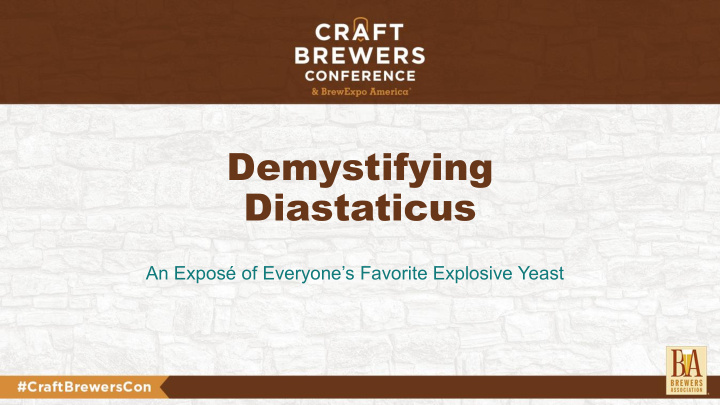



Demystifying Diastaticus An Exposé of Everyone’s Favorite Explosive Yeast
Matt Linske Manager & Lead Microbiologist Brewing and Distilling Analytical Services, LLC BDAS Denver
What is Saccharomyces cerevisiae var. diastaticus? • Saccharomyces = Sugar fungus • cerevisiae = from beer • diastaticus = separation (of starch)
When Yeast Super Attenuation of Beer Goes Variant • Andrews & Gilliland • Describe a “novel species” in 1952 • Later genomic Variant: taxonomic research (~1985) designation below reclassified as species and subspecies S. cerevisiae variant
What makes diastaticus different? It’s in their Genes Starch degradation Molecular Machines Maltotriose STA1 Extracellular Maltotetraose STA2 Glucoamlyase Dextrin STA3 Starch
How it works: The Central • Signal within cell Dogma: activates DNA (gene) Information • DNA transcribed transfer within into mRNA cells • RNA converted to protein by Ribosome
STA Gene family is highly homologous The Glucoamylase Multigene Family in Saccharomyces cerevisiae var. diastaticus: An overview. Pretorius et al. 2008. DEX allelic to STA genes Allelism within the DEX and STA gene families in Saccharomyces diastaticus. Erratt JA, Nasim A. 1986
Rapid Methods for Detecting Saccharomyces diastaticus, a Beer Spoilage Yeast, Using the Polymerase Chain Reaction H. Yamauchi, H. Yamamoto, Y. Shibano, N. Amaya, and T. Saeki, JASBC 1998
Structural analysis of glucoamylase encoded by the STA1 gene of Saccharomyces cerevisiae (var. diastaticus ) Adams et al, Yeast 2004; 21 : 379 – 388.
Enzymatic Action!
Brewing with diastaticus Apparent Gravity vs Time Strains: 1.050 • Brewing Science Institute 1.045 A-18 London Ale III (STA1-) 1.040 1.035 • White Labs WLP566 1.030 1.025 Belgian Saison II (STA1+) 1.020 • Voss Kveik (STA1-) 1.015 1.010 STA1 positive yeast took longest to 1.005 reach terminal gravity, lower FG 1.000 0 1 2 3 4 5 6 7 8 than STA1 negative yeast! BS1 A18 WLP566 Voss Kveik
Not all diastaticus Fermentations are the same Saccharomyces cerevisiae variety diastaticus friend or foe? — spoilage potential and brewing ability of different Saccharomyces cerevisiae variety diastaticus yeast isolates by genetic, phenotypic and physiological characterization. Tim Meier-Dörnberg et al, 2018
Differences in Fermentation Related to Different Gene Expression A deletion in the STA1 promoter determines maltotriose and starch utilization in STA1+ Saccharomyces cerevisiae strains. Krogerus et al 2019
Differences in Fermentation Related to Different Gene Expression A deletion in the STA1 promoter determines maltotriose and starch utilization in STA1+ Saccharomyces cerevisiae strains. Krogerus et al 2019
Diastaticus as a Contaminant Locations, Effects, & Detection
What Potential Impacts happens Over-attenuation • Final gravity 1.004 or less when • Flavor imbalance • Package failure diastaticus • Bottle bombs or Can shrapnel = SAFTEY ISSUE!!! is Phenolic Off Flavor • Not all strains POF+ present? Sediment/haze
Where does contamination occur? • Brewhouse • Pipework • Pitching yeast • Fermentation cellar • Packaging lines Incidence of Saccharomyces cerevisiae var. diastaticus in the Beverage Industry: Cases of Contamination, 2008 – 2017 Tim Meier-Dörnberg et al 2017
What is the level of risk? Low Cell numbers can still cause problems! Best practice: Zero Tolerance The Viability of Minimal Numbers of Saccharomyces diastaticus in Beer, Robert P. Greenspan (1966)
Methods of Detection Total Polymerase Plate Chain Counts Reaction
% RECOVERY NBB VS. YPD + CuSO 4 250 PPM 300 PPM 350 PPM 140.0% 120.0% 100.0% 80.0% 60.0% 40.0% 20.0% 0.0%
168.49% 59.42% 155.47% 141.82% 140.85% 116.67% 128.43% 0.00% 115.49% 81.73% 114.57% 117.14% 104.41% 100.00% % Recovery 2019 LCSM vs. NBB 102.39% 109.62% 102.38% LCSM: 2018 VS 2019 131.43% 100.00% 151.11% 100.00% 0.00% 98.13% 103.13% 97.24% 13.89% 96.88% 26.53% 96.15% 52.17% 95.08% 30.83% 93.53% 83.33% % Recovery 2018 LCSM vs. NBB 86.49% 116.00% 59.39% 50.00% 53.01% 78.05% 42.14% 103.70% 38.59% 0.00% 32.48% 5.71% 29.90% 103.03% 11.38% 58.70% 8.45% 62.95% 5.67% 0.00% 4.46% 48.00% 0.59% 82.00% 0.00% 0.00% 0.00% 0.00% 0.00% 0.00%
IOYB64, % RECOVERY VS NBB FPDM-U FPDM-W LCSM-B LCSM-W 160.00% 140.00% 120.00% 100.00% 80.00% 60.00% 40.00% 20.00% 0.00% 0 24 48 72 96
Optimizing LCSM For Diastaticus WLP 565, % Recovery on LCSM STA1+ #20D-0206, % Recovery on LCSM 120.00% 120.00% 100.00% % Recovery 100.00% 80.00% % Recovery 80.00% 60.00% 60.00% 40.00% 40.00% 20.00% 20.00% 0.00% 0.00% 0 100 200 300 400 500 600 0 100 200 300 400 500 600 CuSO4, ppm CuSO4, ppm Yeast #4: 0.5g (NH4)2-SO4 Yeast #4: 0.75g (NH4)2-SO4 Yeast #206: 0.5g (NH4)2-SO4 Yeast #206: 0.75g (NH4)2-SO4
• Enzoklop - CC BY-SA 3.0, https://commons.wikimedia.org/w/index.php?curid=32003643
A Primer on Primers • Short, single-stranded nucleic acid utilized in the initiation of DNA synthesis • Both Forward and Reverse Needed to Amplify Gene of interest • By Zephyris - CC BY-SA 3.0, https://commons.wikimedia.org/w/index.php?curid=26794032
Real Time PCR • DNA amplification detected by fluorescent dyes • Can be visualized in Real Time!
End Point Detection
Thank you! • Team BDAS • Chuck Skypeck and BA Staff • Justin Levaugn • Jess Caudill • David Bryant • Lance Shaner & Laura Burns • Karen Fortmann & Kara Taylor • Spencer Weeks • Tom Boudreau & Dr. Matthew J. Farber
Recommend
More recommend